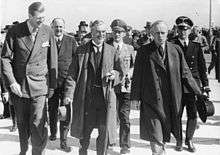Alexander von Dörnberg

Alexander Freiherr von Dörnberg zu Hausen (17 March 1901 in Darmstadt – 7 August 1983 in Oberaula-Hausen, Hesse) was a German jurist, diplomat and SS officer. He was head of the Protocol Department of the Foreign Office from 1938 to 1945.
Life and work

He came from the Dörnberg family of Hessian nobility. In his youth, Dörnberg attended the Reform-Realgymnasium in Kassel. After his Abitur in 1919, Dörnberg joined the Freikorps and participated in the violent domestic disputes in Germany after the end of World War I.[1] He then studied jurisprudence at several universities: Heidelberg, Bonn, Munich, Marburg, and Frankfurt. In 1920, he became a member of the Corps Saxo-Borussia Heidelberg,[2] a student organization, and in 1921 the Corps Borussia Bonn. In 1925, he received his doctorate of law.
In 1926, Dörnberg was for some months private secretary to German Ambassador Ago von Maltzan and to the Embassy of Germany, Washington, D.C., before he officially joined the diplomatic service in 1927. At the Foreign Office, he was first assigned as attaché to Alfred Horstmann. In 1930, he took the diplomatic-consular examination. Subsequently, he was employed as attaché at the Germany embassy in Bucharest from 1930 to 1933.
In 1933, Dörnberg – who attracted attention by his height of about 6 feet 7 inches (2.01 m) – worked for several months in the Disarmament Department of the Foreign Office, before he worked at the Embassy in Tallinn, Estonia from autumn of 1933 to 1936. After a stopover in the Political Department of the Foreign Office from 1936–37, he became a secretary of legation to the Embassy of Germany in London. There was an intensive collaboration between Dörnberg and the then German ambassador to Britain, Joachim von Ribbentrop, with whom he became friends for the first time.[3][4][5]
On 1 January 1934, Dörnberg became the regional leader of the NSDAP in Estonia. In 1938, he also joined the SS, in which he reached the honorary rank of SS-Oberführer.[3] In July 1938, Dörnberg was appointed as the successor to Vicco von Bülow-Schwante as Chief of the Protocol Department of the Foreign Office. He remained in this post until the collapse of the Nazi regime in 1945. In the fall of 1938, Dörnberg received British Prime Minister Neville Chamberlain during the negotiations over the Munich Agreement. In August 1939, he accompanied Ribbentrop to Moscow to sign the Molotov–Ribbentrop Pact.
As a diplomat, Dörnberg held the title of Envoy Extraordinary and Minister Plenipotentiary.
Post-war
After the German surrender, Dörnberg was arrested by the Allies and interrogated during the Nuremberg trials as a witness, especially in the Ministries Trial.
Greater public attention was given Dörnberg posthumously in 2005: The Protocol Department of the Foreign Office had Dörnberg's portrait photograph inserted between the heads of department of all successive terms since 1920, hanging in the corridors of Protocol Department on the first floor of the west wing of the Foreign Office building. This led to a dispute about the culture of remembrance of the Foreign Office and aroused the displeasure of the then Foreign Minister Joseph Martin Fischer.[4]
References
- ↑ Henrik Eberle, Matthias Uhl: The Hitler Book. The Secret Dossier Prepared for Stalin., 2005, p. 313
- ↑ Kösener Corpslisten 1996, 140, 1345
- 1 2 Paul Schwarz: This Man Ribbentrop. His Life and Times, 1943, p. 78
- 1 2 Der Spiegel 11 April 2005, p. 34
- ↑ Seabury, 1954
Bibliography
- Maria Keipert (Red.): Biographisches Handbuch des deutschen Auswärtigen Dienstes 1871–1945. Herausgegeben vom Auswärtigen Amt, Historischer Dienst. Band 1: Johannes Hürter: A–F. Schöningh, Paderborn u. a. 2000, ISBN 3-506-71840-1
- Eckart Conze, Norbert Frei, Peter Hayes und Moshe Zimmermann: Das Amt und die Vergangenheit. Deutsche Diplomaten im Dritten Reich und in der Bundesrepublik. Karl Blessing Verlag, München 2010, ISBN 978-3-89667-430-2.
- Hans-Jürgen Döscher: SS und Auswärtiges Amt im Dritten Reich. Diplomatie im Schatten der „Endlösung“. Ullstein, Frankfurt 1991, ISBN 3-548-33149-1
- Paul Seabury: Die Wilhelmstraße. Die Geschichte der deutschen Diplomatie 1930 - 1945. Frankfurt am Main 1956, p. 115
External links
| Wikimedia Commons has media related to Alexander von Dörnberg. |